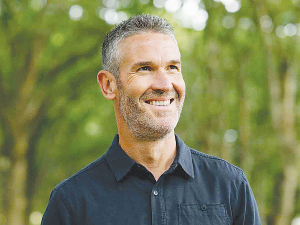US tariffs boost NZ wool carpet export opportunity
A 50% tariff slapped by the US on goods from India last month has opened an opportunity for New Zealand wool carpets exports to North America.
 Bremworth chief executive Greg Smith says a lift in revenue is anticipated for the next financial year.
Bremworth chief executive Greg Smith says a lift in revenue is anticipated for the next financial year.
Damage caused by Cyclone Gabrielle to Bremworth's Napier plant resulted in severe capacity constraints for the carpet maker and a poor half-year performance.
The listed company says it has been unable to grow revenue, resulting in a $1.7 million net loss for the half year to December 31, 2023. Half-year revenue reached $39m - 17% below the same period in 2022.
However, it's not all bad news for the company. The message from its retail partners is that demand for Bremworth products continues.
Chief executive Greg Smith says with the pending near-term return of full production volumes, a strong cash balance and the release of new ranges, a corresponding lift in revenue is anticipated for the next financial year.
"As supply improves at the quality and quantity required, we will be able to meet existing demand and rebuild our inventory position," says Smith.
"This then supports participation in larger commercial developments and the expansion of our in-store presence in over 100 Australian retail stores."
Bremworth has focused on reducing administration and distribution costs to better match its reduced revenue.
However, Smith points out that administration costs would have been about $1m less after excluding litigation costs and the costs relating to the board-led strategic review.
"Once we can match supply with demand in each of our markets, we believe that our post-cyclone adaptation will yield a meaningful improvement to our financial results," he says.
Flooding caused by Cyclone Gabrielle caused extensve damage and forced Bremworth's Napier facility offline. The Napier plant supplied 100% of dyed fibre and about 75% of yarn to its Auckland and Whanganui factories.
Smith says Bremworth has worked hard to establish a fully functioning hybrid supply chain but admits that it has been exceptionally difficult.
"The Napier plant made unique yarns that are hard to recreate anywhere in the world. That said, we have had no choice but to embark on this mitigation strategy.
"At the end of 2023, we had replaced around 60% of our yarn requirements and expect this to be at around 90% by the end of March and fully recovered by the end of FY24.
"The hybrid supply chain we have created minimises the ongoing yarn supply constraints and revenue losses. A return to yarn production in Napier would offer further security to our supply chain.
"Our yarn plant in Whanganui, which produces world-leading specialty yarn, has been fortified by strategic partnerships with both domestic and overseas yarn manufacturers who align with our quality standards, whilst Napier remains offline. These collaborations will enable us to scale production and help insulate our supply chain from potential future shocks."
Insurance claims around the Napier plant damage are ongoing. Smith says it is working closely with insurers concerning reinstatement at Napier under its material damage policy.
Stage 1 of the rebuild, involving the reopening of a dyehouse, has been completed, with dyeing operations now underway.
"The staged approach to reinstatement of the plant is consistent with our objective of providing security of supply for the future while complementing the hybrid supply chains.
"The loss of our continuous finishing line at Napier has been particularly hard to find a solution for and is the next stage being considered.
"Loss of sales, margin losses and ongoing fixed costs incurred during the indemnity period will form the basis of our business interruptin insurance claim.
"Investment has also made in machinery in Whanganui to strengthen our capability to make new products and increase production volumes," he says.
Full Production
Bremworth anticipates a return to full production volumes for the carpet business within the next three months.
The listed carpet maker says its uniquely designed new carpet ranges will be released across New Zealand and Australia.
Chief executive Greg Smith says these highly anticipated product innovations are expected to be well received by retailers and consumers.
"While the weather events of last year forced the rationalisation of some of our ranges, these new releases, our first since the cyclone, are expected to provide a welcome boost to revenue in FY25."
An independent report, prepared for Alliance farmer shareholders is backing the proposed $250 million joint venture investment by Irish company Dawn Meats Group.
Whangarei field service technician, Bryce Dickson has cemented his place in John Deere’s history, becoming the first ever person to win an award for the third time at the annual Australian and New Zealand Technician of the Year Awards, announced at a gala dinner in Brisbane last night.
NZPork has appointed Auckland-based Paul Bucknell as its new chair.
The Government claims to have delivered on its election promise to protect productive farmland from emissions trading scheme (ETS) but red meat farmers aren’t happy.
Foot and Mouth Disease outbreaks could have a detrimental impact on any country's rural sector, as seen in the United Kingdom's 2000 outbreak that saw the compulsory slaughter of over six million animals.
The Ministry for the Environment is joining as a national award sponsor in the Ballance Farm Environment Awards (BFEA from next year).

OPINION: For years, the ironically named Dr Mike Joy has used his position at Victoria University to wage an activist-style…
OPINION: A mate of yours truly has had an absolute gutsful of the activist group SAFE.